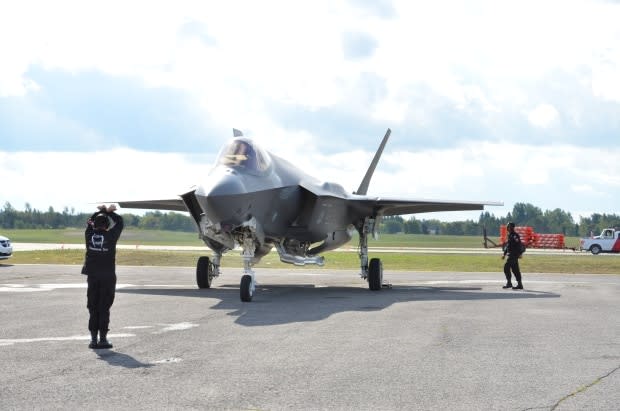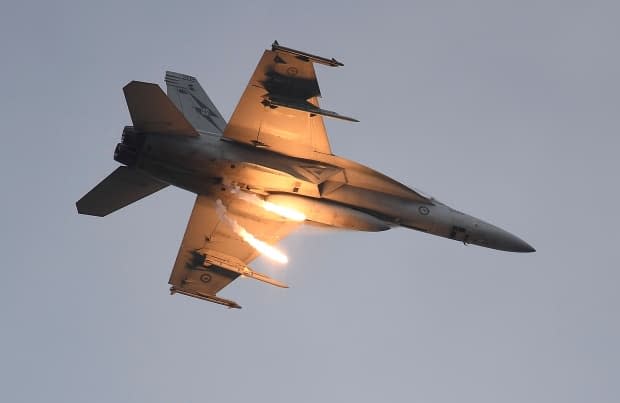Deadline to submit bids to build Canada's next fighter jets lands today
It's a once-in-a-generation event. The last time the federal government faced a decision of this kind, Pink Floyd's "Another Brick in the Wall" was playing on the radio.
Today is the submission deadline for the three aerospace firms bidding for the right to build Canada's next fighter jet.
Public Services and Procurement Canada confirmed it has received three proposals — one each from U.S. defence giants Lockheed Martin and Boeing, and one Swedish aircraft-maker Saab.
The Liberal government pushed back the deadline for the $19 billion competition to the end of July because of the pandemic crisis.
On April 10, 1980, a previous Liberal government chose the McDonnell Douglas (later Boeing) CF-18 as the backbone of the country's fighter jet fleet.
The current government is not expected to make a decision on whether to buy the Lockheed Martin F-35, Boeing's Super Hornet (a newer, beefier version of the F-18) or Saab's Gripen-E for several months. The first jets likely won't arrive until 2025.

In retrospect, buying the CF-18s was a walk in the park compared to the procurement experience of a generation of federal officials since a replacement for the CF-18 was first discussed in the late 1990s.
The government of former prime minister Pierre Trudeau decided in March, 1977 to buy a new fighter. Three years later, bids had been submitted and a contract was signed. Two years after that, the first CF-18s were on the flight line.
If only it could have been that easy this time around.
"The road we have been on in this journey has been long and torturous," said Dave Perry, an expert in defence procurement who has followed the fighter jet file for a decade.
It was Jean Chrétien's Liberal government that started the ball rolling by joining a U.S.-led program to construct among allies a new, affordable stealth fighter — a proposal that eventually morphed into the F-35.

A dozen years later, when Stephen Harper was prime minister, the Conservative government signalled its intention to buy the F-35. That pitch triggered a storm of political and defence opposition that dragged in the Parliamentary Budget Office and, eventually, the auditor general.
The problem, said University of British Columbia defence expert Michael Byers, is that the Canadian air force has only ever wanted the F-35.
"They thought they had it done and dusted with the Conservatives until Kevin Page started to pull it apart," Byers said, referring to the former parliamentary budget officer who first questioned the cost of the planned acquisition.
'Just bonkers'
The plan became even more politically toxic when the Liberals promised in 2015 not to buy the stealth fighter — to acquire something cheaper instead.
Successive governments have "ragged the puck," said Byers, and politicians have avoided tough decisions that would "annoy the generals, the U.S. government or the Canadian public."
Upon assuming office, the Liberals under Prime Minister Justin Trudeau embarked on a ponderous round of industry consultations and reviews that pushed the deadline for buying new fighters out past the last election in 2019.
"It did not need to go on this long," said Perry. "They tried to maximize the competitive environment [for aerospace companies] but in general, it has been just bonkers."
It was always going to be tough, Perry added, to have a competition on a level playing field because of the structure of the F-35 program, which provides industrial benefits to Canadian companies. Those benefits make it tough to measure the cost and value of the F-35 against its competitors.
Federal officials were forced to find workarounds to keep Lockheed Martin in the competition.
In a statement, Lockheed Martin said Canada has been a valued partner since the inception of the Joint Strike Fighter competition in the late 1990s and it is convinced the stealth fighter will "transform the Royal Canadian Air Force fleet and deliver the capabilities necessary to safeguard Canadian skies."
In its own statement, Saab said its Gripen fighter is designed to operate in harsh environments and defeat the most advanced global threats, and the aircraft meets all of Canada's specific defence requirements.
The Liberal government plans to buy 88 new fighter jets. It will have to start paying for them just as the navy is expected to start receiving the first of its new frigates.

Sticker shock
Both bills will come due at a time when the federal government will still be digging itself out of pandemic debt.
Perry said he's concerned.
"When the government's deficit is eye-wateringly large and its revenue hole is astoundingly high," he said, a finance minister might "hesitate" to approve a military contract worth many billions of dollars.
One factor that could influence the program is whether the pandemic has forced aerospace companies to increase prices beyond what was anticipated, in order to account for economic conditions and supply uncertainty.
The most likely outcome for the program in the current dire fiscal climate, said Byers, is Ottawa opting to buy fewer planes. He pointed out that the Conservatives had planned to purchase only 65 jets — the minimum number the air force said it needed to do its job.
The federal government cannot avoid the program entirely, he added.
"We will be buying fighter jets. The questions are, how many? And from whom?"


